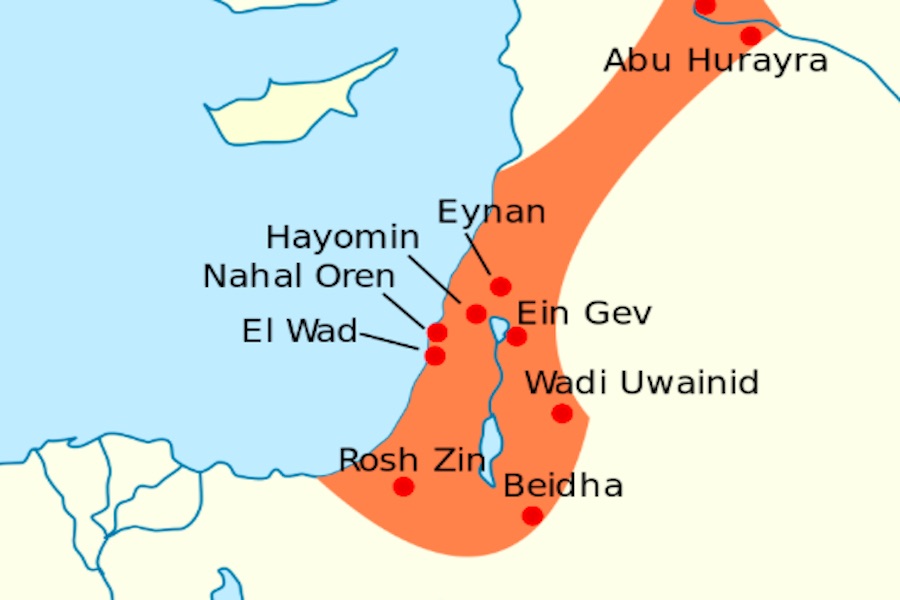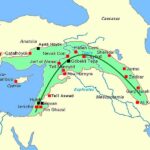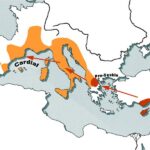ナトゥーフ文化(英語:Natufian culture)は、紀元前12500年から紀元前9500年にかけてレバントに存在した亜旧石器文化。 人類史において農耕が始まる前であるにも関わらず、定住あるいは定住に近い生活が行われていた点に特徴がある。 おそらく世界最古の都市であるとされるイェリコは、この時期に建設された。 いくつかの考古学的証拠は、穀物、特にライ麦の計画的な栽培が、ナトゥーフ文化期後半にテル・アブ・フレイラにおいて行われていたことを示しており、これは人類史における最初の農耕の証拠である[1]。
https://ja.wikipedia.org/wiki/ナトゥーフ文化
ナトゥーフ文化(ナトゥフィアン文化)は最古の農耕とみなされる可能性がある。この文化の後に、土器前新石器時代Bが生じた。おそらく、これらの主体のどちらもが古代エジプト人の父系であるだろう。
ナトゥーフ文化(ナトゥフィアン文化)
俺系統の認識1.1 ナトゥーフ文化は文化である、かつそれは1万五千年前から1万年前にレヴァントでおそらくY染色体ハプログループE1b1によって形成された。
ナトゥーフ文化における主体がどの種の言語を話していたのかは不明である。しかし、もし彼らがY染色体ハプログループE1b1bを持つならば、彼らはEに対応する言語を話していた可能性がある。言い換えると、彼らは古代エジプト語や古代北アフリカに関係する言語を話していた可能性がある。
According to ancient DNA analyses conducted in 2016 by Iosif Lazaridis et al. and discussed in two articles “The Genetic Structure of the World’s First Farmers” (June 2016) and “Genomic Insights into the Origin of Farming in the Ancient Near East (July 2016)[24][39] on Natufian skeletal remains from present-day northern Israel, the remains of 5 Natufians carried the following paternal haplgroups:
E1b1b1b2 (xE1b1b1b2a, E1b1b1b2b) – meaning an unspecified branch of E1b1b1b2 E1b1 (xE1b1a1, E1b1b1b1) – i.e. a branch of E1b1 that is neither E1b1a1 nor E1b1b1b1. E1b1b1 – originally classified as CT but further defined as E1b1b1 by Martiniano et al. 2020.[40]
Haplogroup E1b1 is primarily distributed in Africa,[41] and is present at lower frequencies in the Middle East, mainly in Egypt (40%), Jordan (25%), Israel (20%), Palestine (20%), and Lebanon (17.5%).[42]
https://en.wikipedia.org/wiki/Natufian_culture
上記を見ると、ナトゥーフ文化の主体はY染色体ハプログループE1b1bであるように思える。ここから推測すると、彼らは古代エジプト人である。もともと、Y染色体ハプログループE1b1bは北アフリカだけでなく中東にも住んでいた可能性がある。一般的には、Y染色体ハプログループJが中東を住処とするように思える。核ゲノムは次である。
In terms of autosomal DNA, these Natufians carried around 50% of the Basal Eurasian (BE) and 50% of Western Eurasian Unknown Hunter Gatherer (UHG) components. However, they were distinct from the northern Anatolian populations that contributed to the peopling of Europe, who had Western Hunter Gatherer-like (WHG) inferred ancestry, in contrast to Natufians who lacked this component.
Natufians were strongly genetically differentiated,[43]This might suggest that different strains of Basal Eurasians contributed to Natufians and Zagros farmers,[44][45][46] as both Natufians and Zagros farmers descended from different populations of local hunter gatherers. Contact between Natufians, other Neolithic Levantines, Caucasus Hunter Gatherers (CHG), Anatolian and Iranian farmers is believed to have decreased genetic variability among later populations in the Middle East.
The scientists suggest that the Levantine early farmers may have spread southward into East Africa, bringing along Western Eurasian and Basal Eurasian ancestral components separate from that which would arrive later in North Africa.
https://en.wikipedia.org/wiki/Natufian_culture
ナトゥーフ人は基底ユーラシア人の50パーセントと西ユーラシア系統の不明な狩猟採集民の50パーセントを持つ。俺は上記の翻訳がナトゥーフ人の遺伝子が50パーセントのユーラシア人と50パーセントの狩猟採集民からなるのかを理解できなかった。
また、ナトゥーフ人はアナトリア農耕民と異なる可能性がある。基底ユーラシア人の異なる系統がナトゥーフ人とザグロス農耕民に貢献したかもしれない。彼らは地方における異なる狩猟採集民の人口を先祖に持つ可能性がある。
ナトゥーフ人は東アフリカへと南下した可能性がある。


